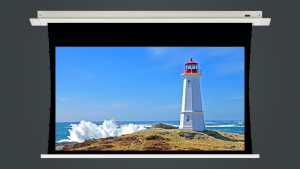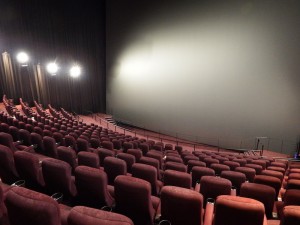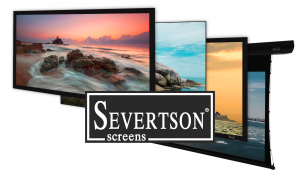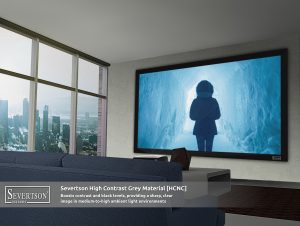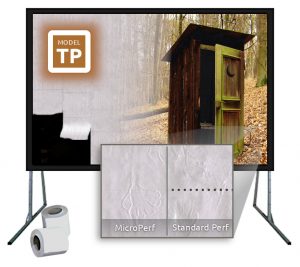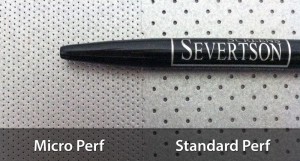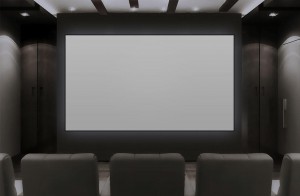A.T. Still University Utilizes 175-Inch, 16:9 Aspect Ratio Severtson Screens SēVision 3D GX Projection Screen for New Virtual Anatomy Lab
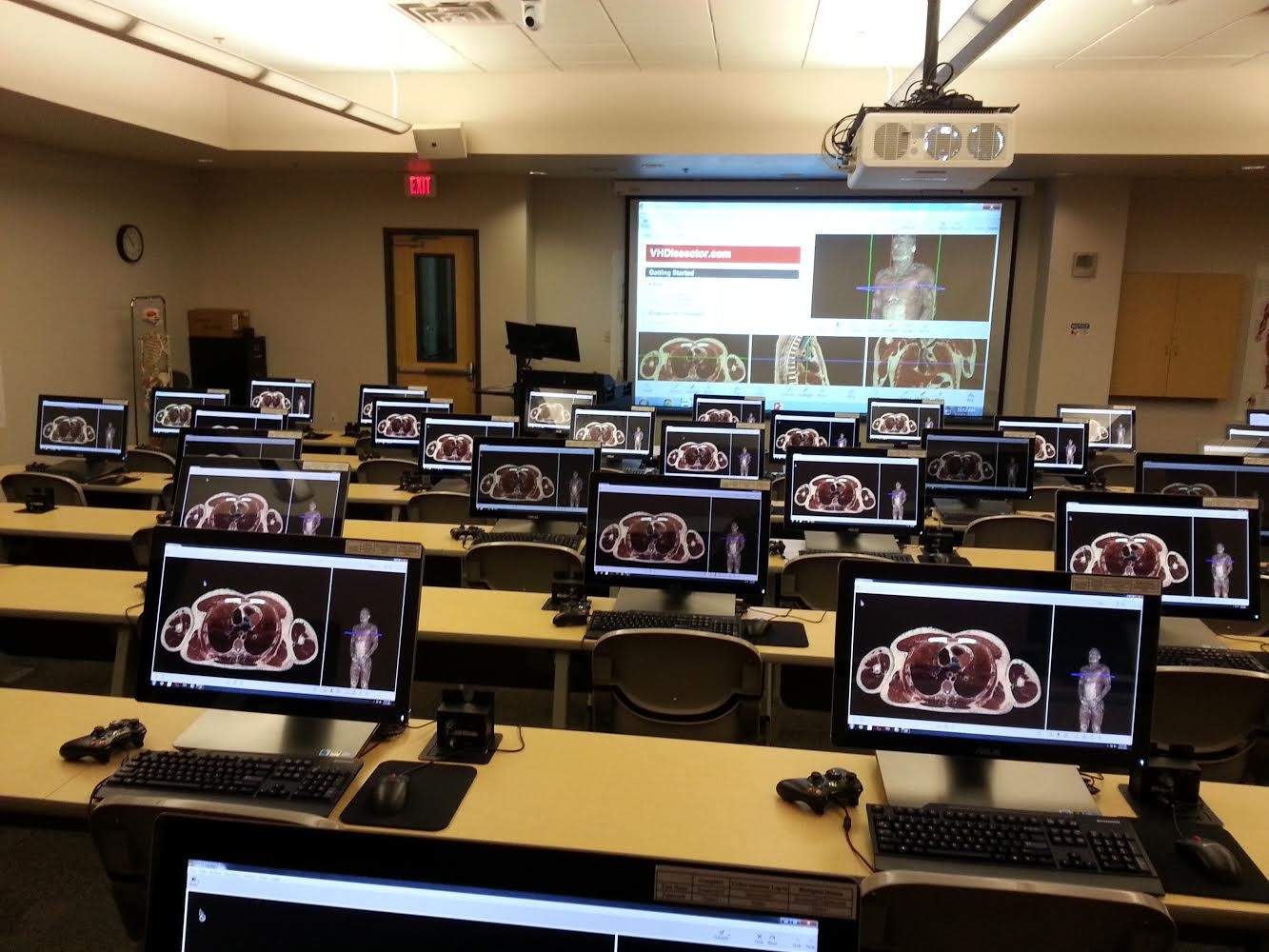
Students at the Mesa, Ariz.-Based University’s School of Osteopathic Medicine Can Sit in a Purpose-Designed $500,000 Classroom and Have Practical “Virtual” Contact with Simulated Human Anatomy
Mesa, Ariz., Feb. 24, 2014 – Prosthetic human bodies have taken a back seat and actual human cadavers now have competition as medical students at Mesa, Ariz.-based A.T. Still University (ATSU) can now sit in a purpose-designed $500,000 classroom and have practical “virtual” contact with simulated human anatomy. This educational practice is now possible thanks in part to a recently installed 175-inch, 16:9 aspect ratio Severtson Screens motorized SēVision 3D GX projection screen in ATSU’s School of Osteopathic Medicine’s (ATSU-SOMA) new state-of-the-art Virtual Anatomy Lab.
Available since November 2013, both university officials and students alike say that the class is nearly as lifelike as actually standing over and performing skilled medical procedures on human cadavers as pieces of the human anatomy are dissected and rotated in larger than life 3D modeling.
“Our 56-seat lab is the first of its kind in Arizona, and only one of a handful of similar labs nationwide,” explained Jay Crutchfield, MD, assistant professor and anatomy director, ATSU-SOMA. “The computer systems and dual state-of-the-art computer software we utilize offer students, as well as participants in continuing education conferences, an incredible 3D visual of the human anatomy without the drawbacks and limitations of working on human flesh that, once altered via dissection by an instructor or student, can’t be put back together and studied again.”
Crutchfield added that with such sophisticated software being utilized in such a unique atmosphere, A.T. Still University’s video requirements were quite demanding as the visual reproduction of the BodyViz, Cyber-Anatomy, 4DAnatomy, and VH Dissector software is crucial in this environment and so the video equipment must be state-of-the-art, as well.
“Poor video reproduction would render the software, and the program itself, useless for our students and guests,” Crutchfield continued. “This is not a home theater, company boardroom, museum, or cinema where the lights will go completely dark and the only visual is the screen. Ambient light from the hallway, the students’ and instructor’s computer monitors, as well as periodically dimmed overhead lighting made us realize that we needed a projection screen that could not only reproduce the necessary 3D imagery precisely, but also take into account the limitations of the room itself. The Severtson Screens SēVision 3D GX reproduces the 3D imagery from the Panasonic PT-DZ870E DLP™ 3D projector incredibly, even when ambient light is present. It is exactly what we needed for this program.”
Severtson Screens SēVision 3D GX offers PristiVue© technology, a revolutionary 3D coating on the screen material, which made it the perfect solution for ATSU-SOMA’s lab’s requirements.
“Proudly ‘Made in the USA’, the Severtson SēVision 3D GX projection screen that is in use in A.T. Still’s virtual anatomy lab provides the ultimate 3D experience by giving instructors the flexibility to show their projections in 2D or passive 3D formats, enhancing the students’ experience while keeping costs down,” said Kirk Severtson, Severtson Screens COO. “We are proud of the way our screen technology contributes to the education of healthcare students here in Arizona.”
According to the university, students will still take standard anatomy courses using real cadavers as nothing can truly replace working with an actual human body. However, according to university officials, simultaneously studying in the virtual anatomy lab will allow students to replace some the monotony of “lost time” preparing cadavers for course work whereas in the virtual lab, they immediately begin studying the human anatomy. Also, they added, working virtually, in some instances, allows students to better see different parts of the human body quickly and more clearly versus a cadaver.
A.T. Still University (www.atsu.edu) is the original founding institution of osteopathic healthcare, established in 1892 by Andrew Taylor Still. As a leading health sciences university, ATSU is comprised of two campuses (Kirksville, Mo., and Mesa, Ariz.) on more than 200 acres with six prestigious schools. Learning environments include residential and online medical degrees as well as community-based partnerships worldwide. ATSU has more than 700 employees dedicated to its not-for-profit mission and an average annual enrollment of over 3,100 students from 35 countries.
Since 1986 with its three production facilities in Arizona and its state-of-the-art robotic application system, Severtson Corp. continues to be a global leader in innovation and quality for home theater, education, commercial, and cinema applications worldwide.
For more information, please visit www.severtsonscreens.com, call 480-610-5155, or email sales@severtsonscreens.com.
About Severtson Screens
Mesa, Ariz.-based Severtson Screens, which celebrated its 25th anniversary in 2011, is an award-winning global leader in innovative and quality projection screens in the home theater, pro AV, and cinema markets. Its low rejection rate coupled with the high quality of all its products has made Severtson Corporation the industry standard for quality and customer service worldwide.
From its unlikely origins in the family kitchen to today’s three modern production facilities, Severtson Corporation has remained committed to the principles of innovation and uncompromising quality that have made them who they are today.
